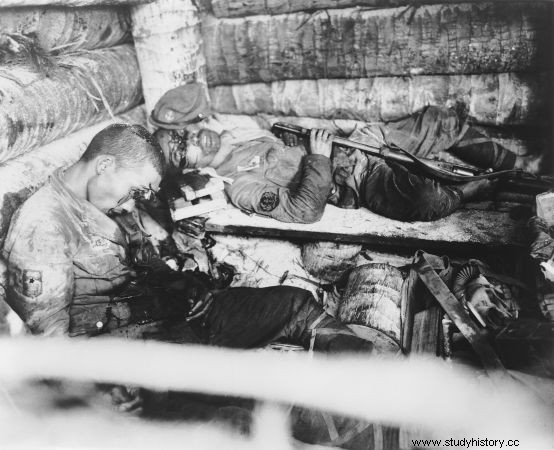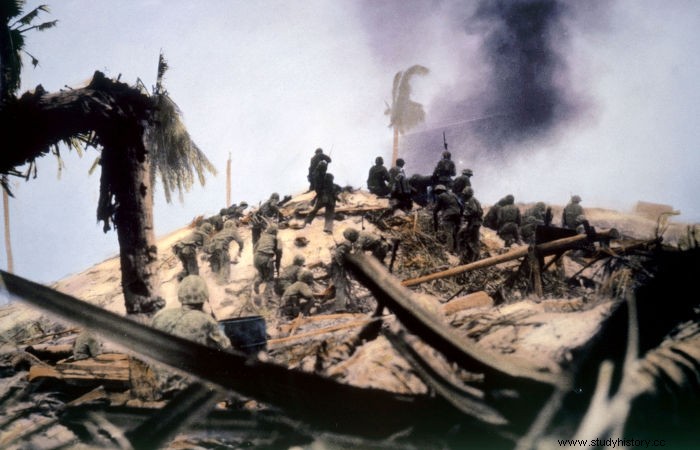
The war scenario in Asia and the Pacific during World War II put Japan as the main forces and the States United . The American entry into the war came after the Japanese attack on the naval base at Pearl Harbor. The Japanese aggressions were part of the program of territorial expansion and colonization of Asia defended by Japan throughout the decade of 1930. The conflicts in the Asian scene were marked by the violence and obstinate resistance of the Japanese. The confrontation between Japan and the United States, which began in 1941, ended in 1945 after the dropping of atomic bombs on Hiroshima and Nagasaki.
Pre-war
Japan, during the 1930s, defended its territorial expansion based on the strength of its armies in order to develop a colonization project throughout the Far East. This project evidenced the nationalism imperialist Japanese, which developed from the reformulation of teaching during the Meiji Restoration (1868). Japanese imperialism was manifested before World War II in events such as:
-
First Sino-Japanese War (1894-1895):Japan conquered the Korean peninsula, which belonged to China;
-
Russian-Japanese War (1904-1905):Conquest of Manchuria and Port Arthur after war with Russia.
Starting in 1933, Japan invaded China with the intention of officially annexing Manchuria to the Empire of Japan. The Japanese invasion of China resulted in the Second Sino-Japanese War (1937-1945), in which Japan committed numerous atrocities against the Chinese civilian population. Two examples of violence committed by the Japanese army are the mass rape cases committed against Chinese women and the use of biological bombs in parts of China.
Japanese expansion foresaw the confrontation with the United States to expel them permanently from Asia (the US had bases and soldiers installed in the Philippines). This would guarantee Japan a clear path to dominate Southeast Asia and thus gain access to the natural resources of these regions.
Shortly before the Japanese aggression against the United States, Japan signed the Tripartite Pact and became a member of Axis and military ally of Germany and Italy , in 1940. In late 1941, Japan attacked the American naval base at Pearl Harbor and, thus, started the armed conflict against the United States. The attack forced American accession to World War II.
Battles in Asia and the Pacific

American invasion of the Gilbert Islands during the Battle of Tarawa in 1943. Digitally colored photo
Shortly before attacking the United States, Japan had already secured control over French Indochina in a quick invasion that had little resistance from France's colonial troops. When the attack on Pearl Harbor took place, the Japanese government touted it to its people and its Axis allies as a major achievement. However, some members of the Japanese army knew that the achievements made at Pearl Harbor were minimal or none.
In any case, at the beginning of the conflict, Japan managed to expand its Empire in an overwhelming way, successively defeating British, American and Dutch troops installed in Southeast Asia. Thus, the Japanese conquered Malaysia, Burma, Singapore and Hong Kong from the British; the Dutch East Indies for the Dutch, and the Philippines for the Americans.
In all cases, reports tell of extreme aggression with which the Japanese treated civilians and prisoners of war, as historian Max Hastings reports:
The new Tokyo regime was characterized by a brutality that the evicted [British] imperialists, whatever their faults, never showed.
The Japanese began to treat prisoners the way they intended to continue in the war. After the fall of Hong Kong at Christmas 1941, the invaders began an orgy of rape and massacre that extended to nuns and nurses and hospital patients bayoneted in their beds. Similar scenes occurred on Java and Sumatra, the largest islands in the Dutch East Indies […]. The Japanese army maintained in its new conquests the tradition of savagery, established in China […] |1| .
Despite the initial victories, Japan's war capacity was much lower than the American capacity in proportionate measures of the economies of the two countries, that is, the American economy was much larger than the Japanese and thus could finance the war much longer than Japan. This became evident from the second half of 1942, when the United States began to reconquer all the territories occupied by Japan between 1940 and 1942.
Historians consider the Naval Battle of Midway the great milestone of the American turn. In that battle, the US Navy sank four Japanese aircraft carriers and inflicted other heavy material losses on the Imperial Japanese Navy. At that time, Japan lost a good part of its capacity for war by sea and, unlike the United States after Pearl Harbor, it was not able to recover.
The American advance, however, happened slowly. Each stronghold occupied by the Japanese was stubbornly defended, which inflicted heavy losses of troops on the United States. Despite this, new victories progressively took place in the following battles:Guadalcanal , Tarawa , reconquest of Philippines , Iwo Jiwa e Okinawa .
Japanese Surrender
In 1945, with the end of the war in Europe and with Japan surrounded by American forces, the Allies met to discuss the map of post-war Europe and the terms of the Japanese surrender. It was estimated that the territorial invasion of Japan would result in great loss of life (even greater than what happened in the Normandy invasion on D-Day) due to Japanese resistance.
Japan was being punished by the American bombing of its big cities, in addition to having a bankrupt economy. Despite this, refused to surrender. Thus, to avoid a territorial invasion, the United States chose to drop atomic bombs on Hiroshima and Nagasaki . This precipitated the Japanese surrender, but the American decision to drop atomic bombs on civilians was considered a war crime .
After the war, the general command of Japan was handed over to the American general Douglas MacArthur, and Japanese territory was occupied by the United States until 1952. The Allies also organized the International Military Tribunal for the Far East, in which jurists from different Allied nations tried war crimes committed at the behest of Japanese leaders.
|1| HASTINGS, Max. The world at war 1939-1945. Rio de Janeiro:Intrinsic, 2012, p. 231-232.
*Image Credits:Everett Historical and Shutterstock
Take the opportunity to check out our video lesson on the subject:
